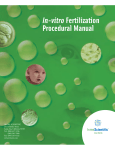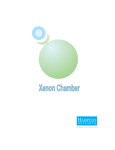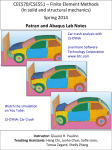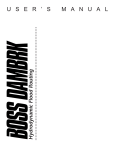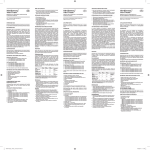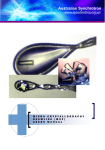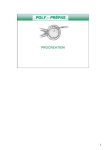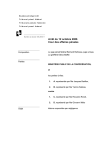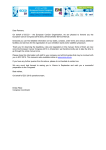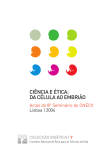Download Product Manual - Nidacon Your Swedish IVF
Transcript
Product Manual Nidation Conception 1. The building of a nidus, a nest, as with birds. 1. The union of male and female gametes, the sperm and egg. 2. Implantation of the fertilized ovum (zygote) and the building of a nest in the endometrium, the placenta. 2. An impression or idea Contents Contents Introduction • Quality ........................................................................................................................................... 4 Quality Assurance ...................................................................................................................................................... 5 Shelf life .................................................................................................................................................................................. 6 Packaging.............................................................................................................................................................................. 6 Product composition .............................................................................................................................................. 7 Products • Ordering information ............................................................................................................. 8 Products ...................................................................................................................................................................... 9-12 Scientifics basics....................................................................................................................................................... 13 Density gradient preparation ......................................................................................................... 14-15 SpeediKit........................................................................................................................................................................... 16 ProInsert ........................................................................................................................................................................... 17 Swim-up ............................................................................................................................................................................. 18 Freezing of spermatozoa...................................................................................................................... 19-21 ICSI .......................................................................................................................................................................................... 22 NidOil ................................................................................................................................................................................... 23 Vitrification and warming of blastocysts ......................................................................... 24-27 Vitality Staining ........................................................................................................................................................ 28 Morphology Staining ......................................................................................................................................... 29 References ....................................................................................................................................................................... 30 Contacts ............................................................................................................................................................................. 31 Introduction • Quality Introduction Nidacon International AB manufactures and sells Medical Devices mainly for Assisted Reproduction Technologies (ART), with IVF, ICSI and insemination (IUI ) solutions. The company was founded in 1996 by Assoc. Prof. Paul V. Holmes MSc, PhD, DrMedSc, an embryologist and endocrinologist from the Dept. of Obstetrics and Gynaecology at Sahlgrenska University Hospital in Gothenburg, Sweden. Nidacon considers many different factors when designing its products. We hope that the attention to detail has helped to create products which will lead to better results. We aim to work in close relation with our customers; they are the cornerstones of our research department. We take pride in the development of our products and make sure we respond to the needs of our customers and research colleagues. All our products are developed in close cooperation with professionals in the different fields. One of the first products to result from the company’s research and development, PureSperm®, was introduced onto the market in November 1996. It has gained rapid acceptance and is now the global market leader for isolation and preparation of sperm used in human assisted reproduction. It was the first product of its kind to achieve both 510(k) clearance from the US FDA and CE marking with the European authorities. Quality Nidacon is certified according to SS-EN ISO 9001 (implemented 2000-12-15) and SS-EN ISO 13485 (implemented 2003-08-15). The management system secures continued development of the organisation. We register our products according to the valid directives and requirements for all different countries. This also ensures our high quality on the market and it shall continue to be our beacon. 0434 Nidacon intends to always maintain the high quality of its products and, in order to achieve this, all batches are 4 tested at Nidacon before they are cleared for the market. Sterility controls are performed on each batch manufactured, the endotoxin level is measured and biological efficacy tests are carried out. A batch is only released for sale if it meets specific criteria. Each batch is accompanied by a quality assurance certificate which records the results of the tests. Using this rigorous quality control system, we ensure that each batch meets the correct standards. Consequently the customers are secure in the knowledge that our products are reliable and will provide good results when used correctly. Quality Assurance Quality Assurance tests Physical analyses pH – tested on every batch during production and after bottled product at room temperature in air. Osmolality – tested on every batch during production and after. Sterility and toxin analyses Microbiological growth control – performed after production of a batch and involve bacterial and fungal growth assays. The assays are performed under a period of 2-3 weeks in order to be able to detect any growth. They are done by the Bacteriological Laboratory of Sahlgrenska University Hospital, Gothenburg, Sweden, an accredited, independent state laboratory. Endotoxin detection – This assay is done with an FDAapproved, Limulus Amoebocyte Lysate (LAL) test using a quantitative spectrophotometric method in order to obtain real values with the units EU/mL, according to the U.S. Pharmacopoeia. The test is done by the accredited laboratory of the Microbiology Institute at the Sahlgrenska University Hospital of Gothenburg, Sweden. Biological analyses Human sperm test – The biological efficacy assay involves assessment of, yield motility, viability measured both subjectively and using computer assisted sperm analysis (Hamilton-Thorne, IVOS). Each batch is tested biologically using human semen samples. The samples are separated into two parts, the one part being used for control and the second part being used for preparing sperm with the new batch. The test-batch results are compared with the results from the control.The analyses provide a count of the sperm per mL, the sperm activity is graded and the activity is also expressed as a percentage of the total sperm. All data are recorded from before and after the separation and purification, and are compared to the control, i.e. using an earlier, already approved batch. Human Sperm Survival test for oil – Prepared sperm are covered by oil and incubated overnight in 37°C, 5-6% CO2. Percentage of motile sperm on day 2. Mouse Embryo Assay (MEA) for bottles etc. – is used to assess the in vitro growth and development of pre-implantation embryos exposed to the test item. The assay predicts embryo toxicities in medical devices or related products to be used for assisted reproductive technology (ART). Mouse Embryo IVF Assay for media – a sensitive assay mimicking the human IVF procedure. The preferred assay to screen assisted reproductive technology supplies for toxicities impairing male and female gamete fecundability and subsequent embryo development capacity. Peroxide analyses – the peroxide level is measured using a QuantiChrom™ Peroxide Assay .The improved method utilises the chromogenic Fe3+-xylenol orange reaction , in which a purple complex is formed when Fe2+ provided in the reagent is oxidised to Fe3+ by peroxidise present in the sample. Functional analysis/ Efficacy test – used to prove the efficacy and function of the products. Visual control – constant visual control during production, filling, labeling and final control of chosen ready packages. 5 Shelf life • Packaging Shelf life Nidacon is conscious of customer requirements and always tries to provide products which are convenient. This convenience includes ease of transportation and long shelf life. Therefore, most of the products have a shelf life of one to two years at room temperature. All ingredients are chosen for their temperature tolerance and their stability in aqueous solution. Rigorous shelf life testing has been carried out in Nidacon’s laboratory to ensure that the theoretical stability of the salt formulations is matched by their actual stability when combined in the product. Packaging The packaging for Nidacon’s products has received the same care and attention to detail as the design of the products. Bottles – For most of our products we have chosen borosilicate glass instead of sodium silicate glass to avoid the leaching of sodium from the bottles into the contents during the long shelf life. Research in our laboratory has shown that sufficient sodium ions can leach from a sodium silicate bottle to have a negative effect on the development of two-cell mouse embryos. Therefore, we avoid exposing all cells to raised sodium-ion levels in the products by packaging in borosilicate glass. Stoppers – Based on embryo-toxicity testing of three types of commercially available rubber stoppers approved for pharmaceutical use today, Nidacon chose silicone rubber as the material for the stoppers. We found that both natural latex rubber and butyl rubber are toxic to embryos, preventing development and possibly causing embryonic death. Silicone rubber did not have any detrimental effect, allowing embryonic development and hatching to proceed as usual. Therefore, stoppers made from pharmaceutical silicone rubber were chosen for our products. This convenience includes ease of transportation and long shelf life. 6 Product composition Background Antibiotics Under normal physiological circumstances, sperm undergo a series of maturation changes after ejaculation which enables them to negotiate the different sections of the female reproductive tract, and eventually locate and fertilise the egg. If sperm are to be used for ART, it is essential that any product which is used for sperm preparation must match the sperm’s physiological requirements as closely as possible. If sperm are stimulated excessively, particularly ionically, they become “hyperactive”, a process which results in the sperm using up its energy resources and dying before fertilisation is achieved. Antibiotics are not included in our products for several reasons. Penicillin G, a commonly used antibiotic in cell culture medium, only lasts for approximately 10 days in aqueous solution, being inactivated after this time and the degradation products are cell-toxic. Furthermore, this antibiotic is ineffective against some of the bacteria most commonly found in semen. Streptomycin and gentamycin are cytotoxic. Gentamicin, in particular, has been shown to be toxic to embryos. Therefore, the pH and osmolality of the sperm solutions must be adjusted very specifically to avoid ionic shock and subsequent hyperactivation. Therefore, it seems prudent to avoid including potentially spermicidal components in sperm preparation fluids. Moreover, bacterial contamination in the ejaculate is removed by density gradient preparation. Therefore, the absence of antibiotics in the gradient will not be detrimental to the sperm preparation, and avoids exposing the sperm to potentially toxic compounds. Product composition The component salts of Nidacon’s products are balanced with specific regard to the ion composition of both the ejaculate and the female reproductive tract. This balance ensures a smooth transition from ejaculate to fertilisation medium via the gradient and wash. Buffer Additives and Phenol Red No preservatives or unstable ingredients are added to Nidacon products. In addition, we have decided not to use phenol red in our media, since it has been proven to have estrogenic effects. Gametes have receptors for estrogen and they can be affected by its presence. For instance, it has been shown that estrogen inhibits sperm motility and the acrosome reaction. The zwitterion buffer, HEPES, is included to maintain the pH of the PureSperm® gradient and PureSperm® Wash while working with the sperm on the bench. Fluids designed to maintain pH in a CO2 environment, i.e. in the incubator, are unsuitable for use outside the incubator as they do not possess sufficient buffering capacity to maintain the pH. Fluctuations in pH and temperature are detrimental to sperm survival on the bench. In addition, HEPES has an anti-oxidant effect, reducing reactive oxygen species (ROS) which can be damaging in the sperm preparation. Glucose Glucose is a component of PureSperm® products. Glucose is the primary energy substrate available to sperm in the human female reproductive tract. 7 Products • Ordering information Sperm VitalStain™ Diagnostic Products Sperm MorfoStain™ – One-step vitality stain – One-step morphology stain Sperm Preparation Gradient Preparation PureSperm® 100 Swim-up PureSperm® 40/80 – Gradient stock solution – Ready-to-use gradient Unilayer PureSperm® Wash PureSperm® SpeediKit – Optimised washing medium – IUI Sperm preparation kit ProInsert™ – Gradients simplified PureSperm® Buffer – Optimised PureSperm dilutant PureSperm® Wash – Optimised washing medium Sperm CryoProtec™II Sperm CryoFloater™ – Optimised for freezing sperm – Sperm vapour freezing device SpermCatch™ – Slowing down sperm prior to ICSI Culture Products VitriBlast™ – Vitrification of blastocysts ThermoBlast™ NidOil™ – Warming of vitrified blastocysts – Overlay during embryo culture Ordering information Cat. No. Description Size Cat. No. Description Size PSK-020 PureSperm® 40/80 2 × 20 mL SCP-020 Sperm CryoProtec™II 2 × 20 mL PS40-100 PureSperm® 40 100 mL NO-100 NidOil™ 100 mL PS80-100 PureSperm® 80 100 mL NO-300 NidOil™ 300 mL PS100-100 PureSperm® 100 100 mL SVS-010 Sperm VitalStain™ 2 × 10 mL PS100-250 PureSperm® 100 250 mL SMS-250 Sperm MorfoStain™ 250 mL VBK-010 VitriBlast™Kit 3 × 10 mL TBK-010 ThermoBlast™Kit 4 × 10 mL PI15-5 ProInsert™ 5 kits PS100-1000K PureSperm® 100 4 x 250 mL PSB-100 PureSperm® Buffer 100 mL PSW-100 PureSperm® Wash 100 mL PSW-020 PureSperm® Wash 2 × 20 mL PSSK-070 PureSperm® SpeediKit 10 patient preps CFV-001 Cryofloater vial 1 SC-100 SpermCatch™ CFV-002 Cryofloater straw 1 6 × 100 µL 10 items or more on one purchase order gives 5% discount. We have distributors in most countries, for a complete list take a look at our web page www.nidacon.com 8 Products PureSperm® 100 Sterile, silane-coated, silica colloid in an isotonic salt solution. It is optimised for the preparation of discontinuous density gradients for the separation and purification of human sperm. Shelf life 2 years. 0434 Components Silane-Coated Silica NaCl Glucose EDTA HEPES Purified water CaCl KCl QA Sterility – Osmolality – Endotoxin pH – Human Sperm Survival PureSperm® 40 PureSperm® 80 Ready-to-use density gradient solutions, 40 and 80%. They make work in the lab easier and minimizes the risk for mistakes. Shelf life 2 years. 0434 QA Sterility – Osmolality – Endotoxin pH – Human Sperm Survival Components Silane-Coated Silica NaCl Glucose Pyruvate EDTA KCl Citrate Lactate HEPES Purified water PureSperm® Buffer Balanced salt solution designed specifically for diluting PureSperm® 100 to make up the layers of different densities for a discontinuous gradient. The optimised formulation of PureSperm® Buffer is designed to maximise sperm survival during gradient centrifugation. Shelf life 2 years. Components NaCl KCl HEPES Lactate Pyruvate EDTA Citrate Glucose Purified water 0434 QA Sterility – Osmolality – Endotoxin pH – Human Sperm Survival 9 Products ProInsertTM The ProInsert™ reduces the risk of recontamination of the sperm pellet during sperm retrieval after a density gradient separation. The ProInsert™ is a safe and easy-to-use device, designed for use with Nidacon products. Components Centrifuge tube containing the ProInsert™ PRP (Pellet Retrieval Pipette) Shelf life 2 years. QA Efficacy test – MEA – Sterility – Human Sperm Survival PureSperm® Wash Sterile isotonic salt solution. Optimized for washing the sperm recovered from density gradient preparations, for use in swim-up procedures, for extension of sperm prior to IUI or as a medium for maintaining sperm. Shelf life 1 year. QA Sterility – Osmolality – Endotoxin pH – Human Sperm Survival Components NaCl Pyruvate KCl MgSO4 EDTA KH2PO4 Purified water Glucose HEPES NaHCO3 Lactate hSA (human serum albumin) PureSperm® SpeediKit A kit that provides you with the components required to prepare 10 sperm samples for IUI. It contains ready-to-use tubes for a single layer colloid centrifugation and ready-to-use tubes with PureSperm® Wash for the washing of the pellet after centrifugation. A perfect product for the small clinic, 10 patients/kit. Shelf life 1 year. QA Sterility – Osmolality – Endotoxin pH – HumanSperm Survival 10 Components Silane-Coated Silica KCl NaCl Citrate Glucose Lactate Pyruvate HEPES EDTA Purified water MgSO4 NaHCO3 hSA (human serum albumin) Products Sperm CryoProtecTMII Sterile salt solution containing glycerol, optimised for freezing both gradientprepared sperm and for unprocessed ejaculates. Nidacon recommends the nitrogenvapour freezing technique, since this technique seems to provide the best results after thawing. Shelf life 1 year. Components NaCl KCl HEPES Glucose MgSO4 KH2PO4 EDTA NaHCO3 Lactate Glycerol Pyruvate Purified water 0434 QA Sterility – Endotoxin – pH Recovery rate after freezing and thawing CryoFloater™ A floating device , used when cryo preserving semen or prepared sperm in liquid nitrogen. It provides a constant distance between the sample and the nitrogen surface, to standardize the freezing rate. Components Polyethylene foam QA – Visual inspection Sperm VitalStainTM One step staining technique for assessment of sperm vitality, one of the basic tools in semen analysis. Shelf life 2 years. 0434 Components NaCl Eosin Purified water Nigrosine Formalin QA pH – Functional analysis Sperm MorfoStainTM Classic Romanovsky stain. It is a one-step stain optimised for assessment of sperm morphology. Shelf life 2 years. 0434 Components Methanol Eosin Y Methylene B May Grunwald Giemsa Azur B QA Morphological test 11 Products SpermCatchTM For slowing down sperm prior to ICSI without using polyvinylpyrrolidone (PVP). To avoid ICSI injection of PVP, it contains only natural products for increasing the viscosity. Shelf life 1 year. QA Sterility – Osmolality – Endotoxin pH – Human Sperm Survival Components NaCl Pyruvate MgSO4 Lactate KCl EDTA Purified water KH2PO4 Glucose HEPES NaHCO3 Hyaluronic acid hSA (human serum albumin) NidOil TM Sterile, light paraffin oil for use as an overlay during gamete, zygote and pre-embryo culture in the incubator, or during manipulations outside the incubator. No additives, UV-protective packaging. Shelf life 2 years. Components Light paraffin oil 0434 QA Density – Sterility – Endotoxin – Human Sperm Survival Mouse Embryo assay – Peroxides analyses VitriBlast TM Kit for vitrification of blastocysts based on well tested formulations. Numerous publications demonstrate the effectiveness regarding both survival and pregnancy rates. Shelf life 12 months. QA Sterility – Osmolality – Endotoxin – pH Mouse Embryo assay Components NaCl KCl MgSO4 KH2PO4 Glucose NaHCO3 Pyruvate EDTA Ficoll Purified water HEPES Lactate Sucrose Ethyleneglycol DMSO hSA (human serum albumin) ThermoBlast TM Kit optimised for warming blastocysts vitrified with VitriBlast™ Kit. Ready-to-use solutions. Shelf life 12 months. QA Sterility – Osmolality – Endotoxin – pH Mouse Embryo assay 12 Components NaCl KCl KH2PO4 MgSO4 Glucose NaHCO3 Pyruvate EDTA Purified water Sucrose HEPES Lactate hSA (human serum albumin) Scientific basics Background as sperm decapacitating factors and reactive oxygen species (ROS), both of which negatively affect fertilisation. A normal semen sample (ejaculate) is made up of seminal fluid which contains a number of different cells, cell debris, microbiological and biological substances. After ejaculation in vivo, normal sperm quickly migrate from the liquefied semen into the uterine cervix of the female, thereby separating themselves from adverse affects of the factors previously mentioned. The different cell types contained in semen are normal motile sperm, juvenile sperm and senescent sperm (no fertilisation function) and sperm with DNA breaks. Epithelial cells from the male reproductive tract, male immune cells and cell debris (detritus) are also present in the semen, as are bacteria and possibly viruses. In the andrology laboratory of an IVF-clinic, separation of the normal motile sperm from seminal fluid and its contents can be achieved by using either a “discontinuous density gradient” or a “swim-up”. Moreover, the seminal fluid contains biologicals such Positive features of a discontinuous density gradient according to Nidacon. Feature Density Gradients 4 4 4 4 4 Separates motile sperm from other cell types Separates out immature, aged and dying sperm Separates out morphologically abnormal sperm Separates out sperm with damaged chromatin Removes bacteria and viruses Swim-up 4 If the density gradient has been prepared correctly, the sperm pellet should contain only functional, fertile sperm. The use of two density-gradient centrifugation techniques and the swim-up method to seperate spermatozoa with chromatin and nuclear DNA anomalies. D. Sakkas et al. (2000) Human Reprod. Initial sample Sediment Final prep. Paired t-test Swim-up 21.5 +– 9.5 19.6 +– 9.7 22.0 +– 9.5 0.6 PureSperm gradient 33.9 +– 21.2 25.0 +– 19.8 12.4 +– 12.6 P 0.001 The mean percentage of spermatozoa positive to Chromomycin A3 – decreased presence of protamine. General care and use l All solutions should be brought up to room temperature before use to avoid the temperature fluctuations which are detrimental to sperm survival. l Open and reseal bottles in a laminar air-flow bench using sterile techniques to avoid contamination. l Store all opened bottles at 2-8°C after re-sealing. 13 Density Gradient Preparation PureSperm® 100 PureSperm® 40 PureSperm® 80 PureSperm® Buffer PureSperm® Wash Recommendations If you have a sample with a high volume (>3mL), you can prepare two PureSperm® gradients for each semen sample. This reduces the risk of overloading a single gradient, provides security when handling tubes or recovering sperm pellets and provides two tubes to balance the centrifuge rotor. Reagents and Equipment PureSperm® 100 plus PureSperm® Buffer or PureSperm® 40 and 80 Sterile Pasteur pipettes PureSperm® Wash Sterile 2 mL and 10 mL pipettes Bench top centrifuge with swing out rotor Procedure 5. Centrifuge at 300 x g for 20 minutes. Make sure that your centrifuge uses the correct g-force (use equation, p. 13). Do not use the brake. 1. If you use PureSperm® 100, dilute with PureSperm® Buffer to make your gradient solutions, for example add 2 mL PureSperm® Buffer to 8 mL PureSperm® 100 to obtain 10 mL 80% PureSperm®. Add 6 mL PureSperm® Buffer to 4 mL PureSperm® 100 to obtain 10 mL 40% PureSperm®. Instead you can use the readyto-use PureSperm® 40 and PureSperm® 80 solutions. 6. Aspirate in a circular movement from the surface everything except the pellet and 4-6 mm of the 80% PureSperm® layer. If no pellet is seen after centrifugation, remove all fluid except the lowest 0.5 mL. 2. Use a sterile pipette to add 2 mL of 80% PureSperm® to a conical tube. 7. Use a new pipette to aspirate the pellet (or the lowest 0.5 mL). Transfer sperm pellet to a new tube and resuspend pellet in 5 mL PureSperm® Wash. Always use a new tube with PureSperm® Wash to avoid contamination from the ejaculate. Combine sperm pellets if double procedure has been used. 3. Use a new pipette to carefully layer 2 mL 40% PureSperm® on top of the 80% layer. It is important not to disrupt the two layers and to maintain a sharp interface. 8. Centrifuge at 500 x g for 10 minutes. Do not use the brake. 4. Layer the liquefied semen onto the gradient. We recommend that you don’t take more than 1,5 mL /gradient or you risk overloading the gradient and not getting a good result. Before centrifugation Before centrifugation After centrifugation After centrifugation 14 14 13 14 12 13 11 12 10 11 9 10 8 9 7 8 6 7 5 6 54 13 14 12 13 11 12 10 11 9 10 8 9 7 8 6 7 5 6 54 Semen Semen Gradient upper layer Gradient upper layer Gradient lower layer Gradient lower layer 14 3 4 2 3 2 Seminal plasma Seminal Upper raft plasma Upper raft Lower raft Lower raft Sperm pellet, selected motile Sperm pellet, population selected motile population 3 4 2 3 2 9. Aspirate PureSperm® Wash supernatant leaving as little liquid as possible above the pellet. If no pellet is seen, leave the bottom 0.25 mL fluid. 10. Resuspend the sperm pellet in a suitable volume of media. The sample is now ready for use. Immotile/dead sperm, debris, epithelial cells, Immotile/dead sperm, leucocytes, bacteria debris, epithelial cells, leucocytes, bacteria Immature & senescent sperm Immature & senescent sperm Motile sperm Motile sperm Density Gradient Preparation Calibrate the centrifuge; to achieve the correct g force, use the equation: Rpm = √[ (g/(1.118 x r)] x 10³ g = the centrifugal force r = rotational radius, the distance (mm) from the centre of the rotor to the bottom of a centrifuge tube in the bucket when raised to horizontal position For example; to achieve 300 x g when radius = 165 mm the centrifuge speed must be: Rpm = √[ (300/(1.118 x 165)] x 10³ = 1275 Conversion table – concert between times gravity /x g) and centrifuge rotor speed (RPM) http://cabinet.weblog.com.pt/arquivo/TR0040dh4-Centrifuge-speed.pdf G Force /RPM calculator http://drycake.com/calculator/gforce.php 2 1 6 7 3 4 8 5 9 10 Tips l Gradients should be layered immediately prior to use but the different density solutions of PureSperm® can be prepared in advance, provided that they are stored at 4°C and brought up to room temperature before use. l Viscous samples can be treated with PureSperm®Buffer. You simply add PureSperm®Buffer to the ejaculat, dilution 1:3, 1 part PureSperm®Buffer and 3 parts sample, incubate for 15-30 minutes at 37°C and the sample is ready for use. l When retrieving the pellet after the gradient centrifugation, care must be taken to avoid contaminating the pellet with components of the ejaculate or upper gradient layer. Therefore we recommend that you use a new pipette after removing most of the gradient to avoid contamination, for example, by bacteria. 15 SpeediKit PureSperm® SpeediKit Background We especially recommend PureSperm® SpeediKit for the smaller clinics or for IUI clinics. PureSperm® SpeediKit is a rapid and efficient alternative to sperm-preps using density ‘gradient’ centrifugation. Everything is included in a convenient kit form for quick sperm preparation, all based on the effective centrifugation through a single layer of PureSperm® colloid, followed by rinsing the sperm with PureSperm® Wash. The kit contains both the PureSperm® colloid and the PureSperm® Wash for 10 patients, already dispensed in centrifuge tubes. You do not need an incubator. Reagents and Equipment Ready-to-use tubes of PureSperm® Unilayer and PureSperm® Wash (included in the kit) Bench top centrifuge with swing-out rotor Sterile Pasteur pipettes Procedure 1. Use a sterile pipette to carefully layer liquified semen (up to 1.5 mL) on top of the PureSperm® Unilayer. If you have a sample volume greater than 1.5 mL, use two tubes. 2. Centrifuge at 300 x g for 30 minutes. Do not use the brake. 3. Use a new sterile pipette to aspirate the supernatant, leaving about 5 mm of liquid above the pellet. If no pellet is seen after centrifugation, remove all fluid except the lowest 0.5 mL. 5. Transfer sperm pellet to the tube containing PureSperm® Wash. Resuspend the sperm. 6. Centrifuge at 500 x g for 10 minutes. Do not use the brake. 7. Use a new pipette to aspirate the supernatant. If no pellet is seen, leave the bottom 0.25 mL fluid. 8. Resuspend the pellet in the remaining PureSperm® Wash. The sperm preparation is now ready for use. 4. Use a new pipette to aspirate the pellet (or the lowest 0.5 mL). 1 16 3 2 1 2 55 6 3 6 7 4 4 7 8 8 ProInsert ProInsertTM Background A density gradient will effectively remove lymphocytes, epithelial cells, abnormal or immature sperm, cell debris, seminal fluid, bacteria and to some extent viruses. When performing a density gradient the only means of retrieving the sperm pellet at the bottom of the tube is to either, go directly through the layers, disrupt them and risking to recontaminate the pellet or to remove as much as possible of the layers, go through the remaining gradient and still risking to re-contaminate. Since the gradient will include many risky contaminants it is crucial that the sperm pellet is not re-contaminated. The ProInsert™ will reduce this re-contamination risk. The insert is included in the centrifuge tube from the start and after the preparation the pellet can be retrieved through a channel which leads all the way down to the pellet without coming in contact with the now contaminated gradient. Reagents and Equipment Centrifuge tube containing the ProInsert™ Centrifuge tube for washing media (PureSperm® Wash) PRP (Pellet Retrieval Pipette) Bench top centrifuge with swing-out rotor Sterile pipettes Procedure for using ProInsertTM 1. Open a ProInsert™ Kit and remove the centrifuge tube containing the ProInsert™. 7. Attach the sperm-retrieval pipette from the ProInsert™ Kit to a 1-2 mL syringe (not illustrated). 2. Use a sterile pipette to add 2 mL of PureSperm®80 to the outer channel. The gradient material will run down into the ProInsert™ chamber, out through a hole at the bottom of the chamber, and down the wall of the centrifuge tube to form a layer at the bottom of the centrifuge tube. 8. Pass the pipette slowly into the ProInsert™ via the central channel, down to the sperm pellet (see graphic), be careful not to disrupt the pellet. Aspirate the sperm pellet. Retract the pipette until the tip of the pipette is safely above the liquid surface, aspirate a little air and retract the pipette from the central channel. (This procedure is to ensure that no contents in the pipette will be lost during transfer to the PureSperm® Wash). Transfer the pellet to the tube containing PureSperm® Wash. Centrifuge at 500 x g for 10 minutes. Do not use the brake. 3. Repeat number 2 above, using a new sterile pipette tip and PureSperm®40, again via the outer channel. 4. Use a new sterile pipette tip to carefully layer liquefied semen (up to 1.5 mL) again via the outer channel. Take care not to touch the edges of the central channel with the semen. 5. Cap the tube and centrifuge at 300 x g for 20 minutes. Do not use the centrifuge brake. Calculate the correct RPM for your centrifuge. 6. Add 5mL PureSperm® Wash to a centrifuge tube 6 3(not illustrated). 5 4 2 3 4 5 9. Aspirate the PureSperm® Wash supernatant, leaving as little liquid as possible above the pellet. If no pellet is seen, leave the bottom 0.25mL fluid. 10. Re-suspend the sperm pellet in a suitable volume of culture/transfer medium (e.g. PureSperm® Wash) to obtain the required sperm concentration for IVF, ICSI or IUI. The sperm sample is now ready for 11 12 9 analysis or use. 10 8 8 9 10 17 Swim-up PureSperm® Wash Background For most situations Nidacon recommends using a discontinuous density gradient for preparing human sperm from semen. However, many customers at some time need to use the swim-up technique and the most ideal product for this purpose is PureSperm® Wash. PureSperm® Wash is a salt solution balanced and adjusted for the nutrition and long survival of human sperm. It functions exceedingly well in this role. Recommendations when using swim-up to prepare sperm for ART. We recommend that you add Penicillin at a concentration of 100 U/mL. Since PureSperm® Wash does not contain any antibiotics and since swim-up cannot guarantee removal of bacterial contamination, it is recommended to add antibiotics Reagents and Equipment PureSperm® Wash Round bottomed centrifuge tubes Disposable sterile conical centrifuge tubes Sterile pipettes CO2 incubator Bench top centrifuge with swing out rotor Procedure 1. Transfer 1 mL of liquefied semen to a sterile round bottomed centrifuge tube. If the sample is too viscous, try diluting it with PureSperm® Buffer before. 5. Place this fluid in a sterile conical centrifuge tube containing 5 mL PureSperm® Wash. 6. Centrifuge at 500 x g for 10 minutes. Do not use the brake. 2. Use a new pipette to carefully layer 1,5 mL PureSperm® Wash over the semen. 7. Aspirate the supernatant, leaving no more than 2 mm depth of liquid above pellet. 3. Without disturbing the layers, place the centrifuge tube at a 45° angle into a CO2 incubator, at 37°C for 60 minutes. 8. Resuspend the sperm pellet in a suitable volume of medium to obtain the required sperm concentration. The sample is now ready for analysis or use. 4. Carefully remove the uppermost (0,5-1,0 mL) of medium containing motile sperm using a sterile 2 1 pipette. 2 1 2 1 1 3 4 3 3 3 2 4 4 4 Tips l 5 5 18 5 5 6 6 6 6 7 7 7 7 8 8 8 8 If you have a viscous sample, be extra careful when you remove the upper layer after incubation. It is easy to get hold of the semen sample and disrupt the layers. Freezing of spermatozoa Sperm CryoProtecTMII Background The cryoprotectant in SpermCryoProtec™II is glycerol, the proportion being reduced as far as possible to minimize toxicity to sperm, while still providing cryoprotection. Moreover, a high concentration of glucose is present as an osmotic agent to reduce intracellular water; thus diminishing damage due to ice-crystal formation. Recommendations Although it is possible to freeze unprocessed semen, we recommend that you prepare the ejaculate using a PureSperm® density gradient. This method removes seminal plasma as well as ROS and their sources, thereby ensuring optimal recovery of motile sperm on thawing. Reagents and Equipment Sperm CryoProtecTMII and PureSperm® Wash Sterile pipettes Disposable sterile centrifuge tubes (e.g. Falcon 2075) Disposable sterile cryopreservation vials or plastic straws Scissors CryoFloaterTM (Nidacon) Dilution table Sperm Sample (µL) SCPII™ (µL) Sperm Sample (µL) SCPII™ (µL) Sperm Sample (µL) SCPII™ (µL) 100 200 300 400 500 600 700 800 900 1000 33 67 100 133 167 200 233 267 300 333 1100 1200 1300 1400 1500 1600 1700 1800 1900 2000 367 400 433 467 500 533 567 600 633 667 2100 2200 2300 2400 2500 2600 2700 2800 2900 3000 700 733 767 800 833 867 900 933 967 1000 For other volumes than those listed; calculate: Volume Sperm Sample / 3 = Volume SCPII Example: 300 µL Sperm Sample / 3 = 100 µL SCPII Tips l To avoid osmotic shock for the sperm, it is important to slowly mix Sperm CryoProtecTMII with your sperm sample but don’t mix for longer than 5 minutes since glycerol is toxic to cells at RT. l The incubation time before freezing can be reduced to 15 minutes, but we recommend 60 minutes. 19 Freezing of spermatozoa Processed ejaculate 1. Add 1 part of Sperm CryoProtecTMII to 3 parts of sample (see dilution table) ensuring thorough mixing after adding each drop. 4. Place the straws horizontally in nitrogen vapour, above the liquid nitrogen surface on a piece of styrofoam (CryoFloater™). Leave for 30 minutes. 2. Fill straws with sperm suspension or aliquot into vials. 5. Transfer the straws quickly into the liquid nitrogen and, thereafter, store in liquid nitrogen. Do not touch the straw with your hand. 3. Equilibrate straws or vials in refrigerator for 30-60 minutes. 3 2 1 2 1 3 5 4 6 5 4 LN2 Unprocessed ejaculate 1. Measure the volume of the ejaculate. 4. Place the vials in the fridge (4-5°C) for 30 min. 2. Mix ejaculate with SCPII, dilution 1:3 (see table), ensuring thorough mixing after adding each drop in order to avoid osmotic shock. 5. Freeze the vials horizontally in the freezer or in nitrogen vapour, above the liquid nitrogen surface on a piece of styrofoam (CryoFloater™). Leave for 30 min. 3. Transfer 0.8-1.8 ml of the mixture to 2 ml cryovials. 6. Store in liquid nitrogen. H2O 3 2 1 5 2 1 1 3 5 4 3 2 6 5 LN2 20 H2O 6 6 6 Freezing of spermatozoa Thawing procedure processed ejaculate 6. Centrifuge at 500 x g for 10 minutes. Do not use thebrake. 1. Remove the straws from the liquid nitrogen tank. 2. Place straws in water at 37°C for 30 secs. 7. Aspirate PureSperm® Wash supernatant leaving as much liquid as required for desired concentration. If no pellet is seen, leave the bottom 0.10 mL fluid. 3. Dry surface of straw. 4. Cut one end of straw. 8. The sample is now ready for use. 5. Hold the straw over a tube with 5 mL PureSperm® Wash and cut the other end of the straw. Any sperm suspension remaining in the straw can be expelled using a pipette. 1 3 2 4 5 6 7 H2O Thawing procedure unprocessed ejaculate 1 1. Remove the vials from the liquid nitrogen tank. 5. Centrifuge at 300 x g for 20 min. 3 2. Place vials in water 2at 37°C until all ice crystals are gone, approximately 2-3 min. 5 6. Aspirate everything except the6 pellet and 4-6 mm of the PureSperm® 80% layer. 3. Dilute the thawed material with 0.5 ml PureSperm®Wash. 7. Use a new pipette to aspirate the pellet. Transfer to a new tube containing 4 ml PureSperm®Wash. 4. Prepare the thawed material on a 40% and 80% PureSperm® density gradient. Use 1 ml of each for the gradient and layer not more than 1 ml of the thawed ejaculate onto the gradient. 8. Centrifuge at 500 x g for 10 min. 9. Aspirate PureSperm® Wash supernatant and the sample is now ready for use. LN2 1 2 3 4 5 6 6 7 8 9 H2O 1 2 3 4 5 6 7 8 9 21 ICSI SpermCatchTM Background SpermCatchTM is an alternative to PVP (polyvinylpyrrolidone) which today is the most common substance used for slowing down sperm prior to ICSI. However, PVP has been reported to cause problems, such as damaging the sperm plasma membrane. It may also interfere with sperm nucleus decondensation. SpermCatchTM is a solution without PVP, contains instead hyaluronic acid which is a natural component. Several studies have shown that SpermCatch™ gives the same or even better results than PVP. Since SpermCatchTM is a solution containing hyaluronic acid, see the following reference for the advantages. (ref 21) Reagents and Equipment SpermCatch™ NidOil™ Injection media Sterile pipettes ICSI equipment Petri dish Procedure 1. Place a 10 µL drop of SpermCatch™ in the middle of a petri dish. 2. Place 4 drops of 10 µL injection media around the SpermCatch™ drop in the petri dish. 7. Fill your injection pipette with SpermCatch™ to avoid the sperm sticking to the inside of your pipette. It will also help you to make a controlled injection. 8. Immobilise the individual sperm by using the injection pipette to ”knick” the sperm tail. 3. Immediately cover the drops with NidOil™. 9. Aspirate the immobilised sperm. 4. Incubate for 30 minutes in CO2 environment at 37°C. 5. Add 1 µL of prepared sperm suspension to the middle of the SpermCatch™ drop. 6. Incubate for 10 minutes in CO2 environment at 37°C. 1 – 4 10. 1. Move to one of the oocyte droplets. Focus on the oocyte and position the oocyte with the holding pipette. Bring down your injection pipette and inject the sperm. Make sure that the oolemma is broken before you expel the sperm. 5 – 6 7 – 9 SpermCatch™ SpermCatch™ Tips l ICSI dishes must be prepared quickly to avoid osmolarity changes in the media. Only make two at a time. 22 l It is convenient to have two dishes per patient. NidOil TM NidOil Background Mineral oil to overlay the embryo culture is used extensively in IVF laboratories. NidOil™ is a paraffin oil which has been specifically chosen and then treated in our production facilities to ensure that its purity and handling characteristics are suitable for using as an overlay when culturing gametes and embryos. Our stringent quality assurance control helps maintain our standard for low endotoxin levels and also ensures our products are free from microbiological contamination. There have been several reports of paraffin oils becoming embryo-toxic after exposure to light on the laboratory bench. As a precaution against any possible light-induced changes, NidOil™ is packaged in amber, screw-top bottles. NidOil™ does not require washing before use, and it is neither too sticky nor too viscous, to facilitate pipetting. A prospective randomized study to compare four different mineral oils used to culture human embryos in IVF/ICSOI therapy Presented at ESHRE 2008 by Dr C. Sifer, Paris Comparison between; Group 1 2 3 4 No of cycles 129 126 126 119 GQE day 3 2.1 1.6 2.2 2.6 Impl. rate % 22.1 21.7 30.0 24.6 Clin. Pregn % 31 29 38 36 1. Mineral Oil (CryoBioSystem) 3. Liquid Paraffin (MediCult) 3. NidOil (Nidacon) 4. Ovoil (Vitrolife) Recommendations before use NidOil™ should be equilibrated in the same way as the culture medium before use to avoid differences in temperature and gaseous content between the components of the culture system. New Quality Assurance test Many questions has been raised lately to whether the oil that is used for coverage in embryo culture can actually damage the embryo. level in oil can increase over time, due to exposure to light or high temperature storage. All oil batches today from different manufactures are tested for sterility, endotoxins and a mouse embryo assay showing blastocyst development.This is apparently not enough since damage to cultures has been observed with an approved batch of oil. The peroxidase test in now included in our Quality Assurance Certificate which comes with every batch and we also test the raw material before we make the order.In this way we hope to be able to provide you with an oil for your cultures that is safe to use and still practical with the long shelf life and room temperature storage before opening. One answer could be peroxidation of the oil which has been investigated in several publications and found to be harmful to fertilisation and embryo development when over a certain level.It has also been shown that peroxidase If you have any questions regarding our tests, please let us know. 23 Vitrification and warming of blastocysts VitriBlast™ Kit ThermoBlast™Kit Background The formation of intracellular ice crystals is a major problem during the cooling and warming of cells. These ice crystals have detrimental effects on cell survival rates. Vitrification, which is the rapid freezing of cellular mate- rial, makes it possible to freeze cells while at the same time avoiding the formation of intracellular ice crystals. The use of the vitrification technique results in a very homogenous structure, an amorphous crystalline structure. Recommendations VitriBlast™ can be used with different types of vitrification-devices like the cryotop, the cryoloop or the high security straw (HSV). The method described below is with the cryoloop, but the same protocol can be used for all devices. Work on a heated stage at all times when manipulating the blastocyst. Do not let the blastocyst remain exposed to the microscope light during incubation. Reagents and Equipment VitriBlast™ and ThermoBlast™ Kit Sterile pipettes Device for vitrification CO2 incubator Stopwatch Vitrified and warmed blastocyst with excellent morphology. Liquid nitrogen reservoir Liquid nitrogen Culture dishes (NUNC 4-well) Heated stage Inverted microscope Hatching blastocyst after vitrification and warming. Vitrification procedure using the cryoloop Additional equipment: Cryocane for storage of cryo tubes Crystalwand Vial Clamp for holding the cryo tube Cryoloop (Hampton Research) 2. Pipette the vitrification media as described below. When adding the DMSO and Ethylene glycol (EG), which are included in the kit, to solutions 2 and 3, pipette the two up and down a few times to obtain optimal mixing of the media. Well 1 VitriBlast™1 Note: If the additives are stored in the refrigerator, remove them in good time prior to use. DMSO turns solid below +18°C. The additives can be stored outside the refrigerator in the supplied packaging even after opening. If urgent the DMSO bottle can be warmed by holding the bottle in your hand. 1000 µL 1 Well 2 VitriBlast™2 DMSO: EG: 850 µL 75 µL 75 µL Well 3 1. Label the NUNC-dish with the patient ID and each well with corresponding solution number, i.e. 1, 2 and 3. 24 VitriBlast™3 DMSO: EG: 700 µL 150 µL 150 µL 3 2 Vitrification and warming of blastocysts Vitrification procedure using the cryoloop 3. Incubate at 37°C in 5-6% CO2 for 30 minutes, maximum for 1 hour. Longer time makes it difficult to create a film on the loop. 5. Remove the NUNC-dish from the incubator and place it on a heating stage (make sure the heat controller is set high enough to obtain 37°C in the media). 6. Place the punctured and collapsed blastocyst in solution 1. Start the stop watch. 4. During the 30 minute incubation of the dish collapse the blastocyst. This can be done either by laser (Fertilase, red, 5, see pictures below) or by using an ICSI-pipette. Laser • If laser is used, shoot as far from inner cell mass (ICM) as possible. The laser beam shoots vertically, aim as illustrated below. • Be sure that you create a hole through the zona and the trophectoderm. ICSI-pipette • If an ICSI-pipette or other sharp instrument is used, puncture right through the trophoblast cell layer into the blastocoele, and be sure to puncture as far as possible from the ICM. • The pipette should be inserted at the one o´clock position and exit through the blastocyst at the11 o´clock position. 7. After 1.5-2 minutes transfer the blastocyst by aspirating solution 2 into the pipette tip, collect the blastocyst from solution 1 and transfer it to solution 2. 8. Incubate on the heating stage for EXACTLY 2 minutes. Start the stopwatch and observe when 2 minutes is approaching. It is easier to start the stopwatch and let it run towards 2 minute. This removes the stress of the beeping noise when using a countdown timer. While incubating; proceed to step 9. Do not let the blastocyst remain exposed to the microscope light during the incubation. 25 Vitrification and warming of blastocysts Vitrification procedure using the cryoloop 9. During the 2 minute incubation prepare 2 x 10 µL drops of solution 3 in the middle of the dish (see diagram below). The droplets evaporate quickly. It is better to prepare them as late as possible. 13. Immerse in liquid nitrogen. 10. Attach the loop to the Crystalwand. 11. At the end of 2 minutes, transfer the blastocyst by aspirating solution 3 from the well into the pipette tip, collect the blastocyst from solution 2, and transfer it to solution 3 in the 10 µL droplet. The blastocyst must remain in solution 3 for 30–45 seconds, including the time in the loop. 14. Attach the cryo tube to the Vial Clamp and immerse the tube in the liquid nitrogen allowing it to fill. Carefully insert the cryoloop into the tube and keep the cryoloop in liquid nitrogen during the entire procedure. Use the Crystalwand to close the tube. 1 2 3 12. Coat the loop with solution 3 from the unused 10 µL droplet and place the blastocyst on the loop. Note: Using drops reduces the risk of loosing the blastocyst. The blastocyst tends to float on the viscous solution 3. It is also important to incubate solution 3 under the same conditions as the other two solutions, hence the use of 1 mL. 26 15. Attach the tube to the Cryocane for storage in liquid nitrogen. Vitrification and warming of blastocysts Warming procedure 1. Label the NUNC-dish with the patient ID and each respective well with each solution number, i.e. 4, 5, 6. 5. Immerse only the loop in the surface of solution 4. Let the blastocyst fall off. Identify its presence in the well and incubate for 2 minutes on the heating stage. (2 minutes includes time for “locating” the blastocyst). 2. Pipette the warming media 4, 5 and 6 as described below. Well 1 ThermoBlast™4: 1000 µL 1 2 Well 2 ThermoBlast™5: 1000 µL Well 3 3 ThermoBlast™6: 1000 µL 3. Incubate at 37°C in 5-6% CO2 for 30 minutes. 4. Carefully detach the cryoloop from the cryo tube, making sure not to touch the inside of the tube with the cryoloop (the blastocyst may be lost). Unscrewing the top and moving the cryoloop from the tube are the most risk-filled moments during this procedure. 6. Transfer the blastocyst to solution 5. Let the blastocyst simply sink to the bottom, do not wash. Incubate for 3 minutes in solution 5. 7. Transfer the blastocyst to solution 6. 8. Incubate for 5 minutes. 9. Transfer the blastocyst to culture medium and allow the blastocyst time to reexpand. Wait 1 to 4 hours before final assessment. If the blastocyst has not reexpanded after 4 hours the chance of reexpansion is low. 27 Vitality Staining Sperm VitalStainTM Background Sperm vitality should be determined in semen samples with 50% or more immotile spermatozoa according to the WHO laboratory manual for the examination of human sperm. spermatozoa. It is based on the principle that dead cells (i.e. those with damaged plasma membranes) will take up the eosin and stain red. Nigrosine provides the background to facilitate visualisation of the unstained (white) live cells. SpermVitalStainTM uses the eosin-nigrosine technique in a one-step method to establish the percentage of live Reagents and Equipment Light microscope (40 – 100 x magnification) Microscope slides Pipette Test tube Procedure 1. Shake the bottle of Sperm VitalStainTM before use. 2. Take an equal amount of Sperm VitalStainTM and the sperm sample (eg. 50 µL SVS + 50 µL sample). Use for example an eppendorf tube. 7. Cover this slide with a second microscope slide and, when the drop is evenly spread between the two slides, pull them apart from each other horizontally. You then have two good slides. 8. Air dry the two slides and examine. If you want to store for later use, mount the slides with DPX or equivalent mountant, and a cover slide. 3. Mix well. 4. Leave for 30 seconds at room temperature. 5. Prepare a slide using your conventional method or use the method recommended by Nidacon. 6. Transfer a 20 µL drop onto a labelled microscope slide with a pipette, making a string/line of fluid in the middle of the slide. 6 7 Tips l The 100x objective with immersion oil will give you a very clear picture of stained versus unstained sperm. 28 9. Examine using a bright field 40 x objective or a 100 x objective under oil immersion. 10. 0. Count 200 sperm, the white (unstained) are classified as alive and the red or pink are classified as dead. Sperm coloured only at the neck region are classified as alive. Morphology Staining Sperm MorfoStainTM Background The technique is based on the principle that sperm with different characteristics will stain so that one can differentiate between them. The numerical estimation of abnormal sperm in an ejaculate can aid in the judgement of whether, and which kind, of infertility treatment will be necessary. The sperm will be stained in a darker colour (blue) and the background will be lighter. Consequently, the shape, size and integrity of the sperm can easily be determined using 100x objective, oil immersion microscopy. Reagents and Equipment Coplin jar or similar Microscope slides Light microscope (40-100 x objectives) Pipette Procedure 1. Make a semen smear on a microscope slide using your conventional method or the method recommended by Nidacon. 2. Transfer a 20 µL drop onto a labelled microscope slide with a pipette, making a string /line of fluid in the middle of the slide. 3. Cover this slide with a second microscope slide and, when the drop is evenly spread between the two slides, pull them apart from each other horizontally. You then have two good slides. 4. Air dry the smears. 5. Dip the dry smears into the staining solution for 8 seconds. 6. Rinse in double distilled water, changing the water 3 times. Let slides air dry lying flat. 7. Mount the slides with coverslips and DPX, or equivalent mounting fluid, and let them dry completely before examination. 8. Examine using a bright-field 100 x objective under oil immersion. 9. Classify at least 200 sperm, classification according to the 2002 NAFA and ESHRE-SIGA manual on Basic Semen Analysis. 2 3 5 Tips l Use a pencil to mark your sample slides since the stain will remove permanent markers. 29 References References Penicillin degradation products inhibit in-vitro granulopoiesis. Neftel KA et al. Br J Haematol, (1983) 54(2):255-60. Adverse reactions following intravenous pc-g treatment to degradation of the drug in vitro. Neftel et al. Kliniche Wochen Schrift (1984) 62:25-29. Effects of ß-Lactam antibiotics on profilerating eukaryotic cells. Neftel et al, Antimicrobial Agents and Chemotherapy (1987) p 1657-1661. The antibiotic streptomycin assessed in a battery of in-vitro tests for reproductive toxicology. K. Lemiere et al, Toxicology in Vitro (2007) 21:1348-1353. An aminoglycoside antibiotic gentamicin induces oxidative stress, reduces antioxidant reserve and impairs spermatogenesis in rats. K Narayana, J. Tox. Sci, (2007, 33(1):85-96. Bacterial contamination and sperm recovery after semen preparation by density gradient centrifugation using silanecoated silica particles at different g forces. C.M. Nicholson L. Abramsson, S.E. Holm and E. Bjurulf Human Reproduction, Vol. 15, No. 3, 662-666, March 2000. Contamination by seminal plasma factors during sperm selection. Björndahl L, Mohammadieh M, Pourian M, Söderlund I, Kvist U. J Androl. 2005 Mar-Apr;26(2):170-3. Phenol red in tissue culture media is a weak estrogen; Implications concerning the study of estrogen-responsive cells in culture.Y. Berthois et al, Proc. Natl. Acad. Sci, (1986)Vol. 83, pp. 2496-2500. Effects of 17 ß-estradiol on in vitro maturation of pig oocytes in protein-free medium, Qing Li et al, Journ. of Repr. and Development, (2004), Vol 50, No3. Impact of estrogenic compounds on DNA integrity in human spermatozoa: Evidence for cross-linking and redox cycling activities. L.E Bennets et al, Mutation Research 641(2008 ) 1-11. Oogenesis in cultures derived from adult human ovaries. A. Bukovsky et al, Repr. Biol. and Endocr. (2005)3:17 doi: 10.1186/1477-7827-3-17. Estrogenic compounds and oxidative stress (in human sperm and lymphocytes in the Comet assay). Anderson D, et al. Mutat Res. (2003), 544 (2-3):173-8. The use of two density gradient centrifugation techniques and the swim-up method to separate spermatozoa with chromatin and nuclear anomalies. D.Sakkas, Manicardi GC, Tomlinson Human Repr. 2000 May;15(5):1112-6. Recovery and survival of sperm is higher with PureSperm density gradient than swim-up in neat and cryo-preserved-thawed semen specimen. P. Raganathan, A. Agarwal Fertility & Sterility 2001. Platelet-activating factor significantly enhances intrauterine insemination pregnancy rates in non-male factor infertility. W. Roudebush, A. Toledo, H. Kort, D. Mitchell-Leef, C. Elsner, J. Massey Fertility and Sterility, Volume 82, Issue 1, Pages 52-56. Elimination of bacteria from human serum during sperm preparation using density gradient centrifugation with a novel tube insert, Fourie J. et al (2012) Andrologia ,44, 513-517 An alternative to PVP for slowing sperm prior to ICSI. Balaban B, Lundin K et al Hum Reprod. 2003 Sep;18(9):1887-9. “Physiologic ICSI”: Hyaluronic acid (HA) favours selection of spermatozoa without DNA fragmentation and with normal nucleus, resulting in improvement of embryo quality. Parmegiani L, Cognigni GE, Bernardi S, et al. Fertility and Sterility 2009; Advance online publication. Detrimental effects of polyvinylpyrrolidone on the ultrastructure of spermatozoa. Strehler E, Baccetti B, Sterzik K, Capitani S, Collodel G, De Santo M, Gambera L, Piomboni P. Hum Reprod. 1998 Jan;13(1):120-3. Vitrification of mouse and human blastocysts using a novel cryoloop container-less technique. Lane M et al. (1999) Fertility and Sterility. Vol 72, No 6, pp1073-1078. Hyaluronic acid binding by human sperm indicates cellular maturity, viability, and unreacted acrosomal status. Huszar G, Ozenci CC, Cayli S, Zavaczki Z, Hansch E, Vigue L. Fertil Steril. 2003 Jun;79 Suppl 3:1616-24. Perinatal outcome of blastocyst transfer with vitrification using cryoloop: A 4 year follow-up study. Takahashi K et al. (2005) Fertility and Sterility. Vol. 84, No. 1, pp88-92. Why the WHO Recommendations for Eosin-Nigrosin Staining Techniques for Human Sperm Vitality Assessment Must Change. Lars Björndahl et al. Journal of Andrology, Vol. 25, No. 5, September/October 2004. Artificial Shrinkage of blastocoele using either microneedle or laser pulse prior to the cooling steps of vitrification improves survival rate and pregnancy outcome of vitrified human blastocysts. Mukaida T et al. (2006) Human Reproduction. Vol. 21, No. 12, pp3246-3252. Washed paraffin oil becomes toxic to mouse embryos upon exposure to sunlight. Provo, M.B. & Herr, C. (1998), Theriogenology 49, 214. Obstetric outcomes of transfer of vitrified blastocysts Wikland M. et al (2010) Human Reproduction Vol 25, No 7 pp 1699-1707 30 Contacts 1 Vice President Ms. Magda Alic Holmes 5 Marketing Mr. Oscar Rymo 9 Production Mr. Håkan Nilsson 13 Regulatory Affairs Manisha Olausson 2 Production Miho Nilsson 6 Technical Assistant Mr. Sean Graham 10 Product development Ms. Anna Niläng Laessker 14 Marketing Mr. Mauricio Lucena 3 Product Specialist Ms. Ann-Sofie Forsberg 7 Logistics Mr. Dennis Johansson 11 Finance Ms. Kristina Wright 15 Executive Medical Director. MD Dr. Ewa Ustyanowska-Holmes, MD 4 Chief Executive Officer Dr. Paul V. Holmes 8 Marketing Mr. Anders Edvardsson 12 Animal Product Specialist Ms. Emma Holmes 16 Quality Assurance Ms. Marina Danilova 5 6 8 7 9 4 1 2 3 10 14 11 13 12 16 15 If you need further information or have any comments regarding the information in the manual please contact Ms. Ann-Sofie Forsberg Product Specialist [email protected] Tel: +46-31-703 06 30 Fax: +46-31-40 54 15 31 Anfang reklam • 1000 ex • 2015 Flöjelbergsgatan 16 B • S-431 37 Mölndal • Sweden Phone +46-31-703 06 30 • Fax +46-31-40 54 15 [email protected] • www.nidacon.com
































